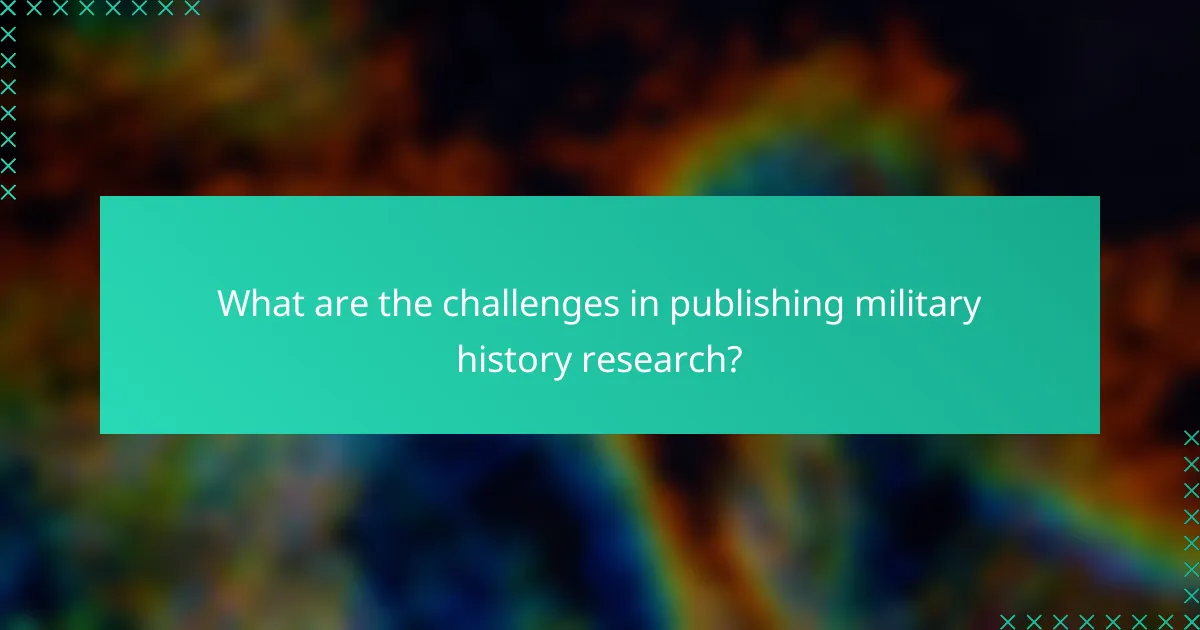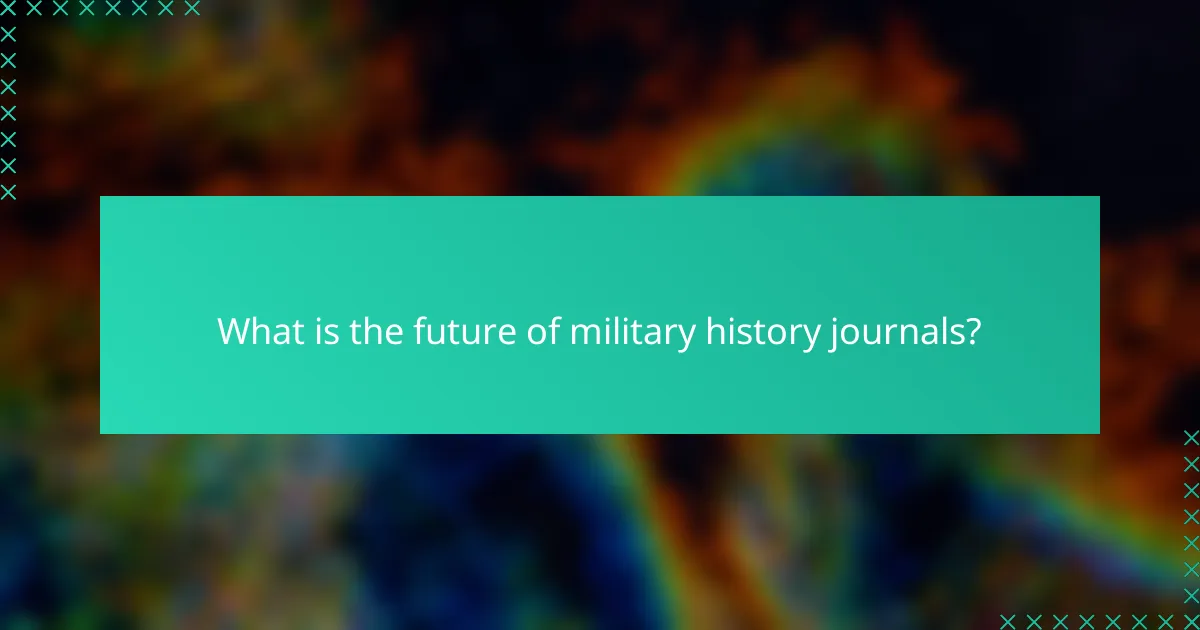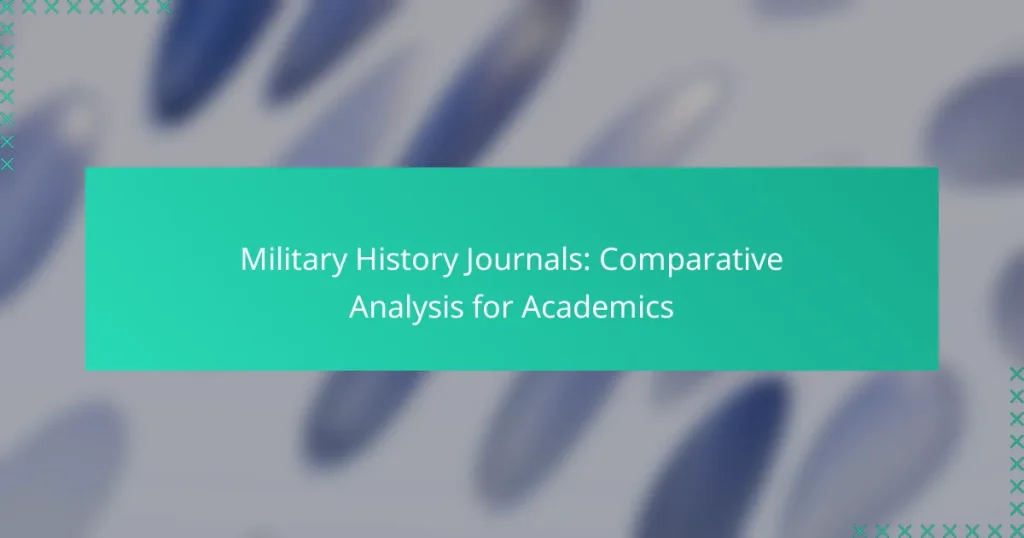Military history journals play a crucial role in advancing academic research by offering rigorous analysis and diverse viewpoints on historical warfare. For scholars, selecting the right journal involves assessing its impact factor, scope, and peer review process to ensure credibility and relevance. Current trends in the field highlight the importance of interdisciplinary methods and a global perspective, fostering innovative approaches to understanding military conflicts and their consequences.

What are the best military history journals for academics?
The best military history journals for academics include reputable publications that provide rigorous research, critical analysis, and diverse perspectives on military history. These journals are essential for scholars seeking to publish their work or stay informed about the latest developments in the field.
The Journal of Military History
The Journal of Military History is a leading publication that focuses on the history of warfare and military institutions. It features peer-reviewed articles that cover a wide range of topics, from ancient battles to modern military strategies.
Academics often consider this journal essential for its scholarly rigor and comprehensive coverage. Submissions typically undergo a thorough review process, ensuring high-quality content that contributes significantly to military history scholarship.
War in History
War in History is known for its interdisciplinary approach, examining the social, political, and cultural dimensions of warfare. This journal publishes articles that not only analyze military events but also explore their broader implications.
Researchers appreciate this journal for its critical perspectives and innovative methodologies. It is a valuable resource for those looking to understand the complexities of war beyond traditional military narratives.
Military Affairs
Military Affairs focuses on the intersection of military history and contemporary military issues. It provides insights into the implications of historical events on current military practices and policies.
This journal is particularly useful for academics interested in the practical applications of military history in modern contexts. It often includes case studies and analyses that bridge historical knowledge with contemporary challenges.
Journal of Strategic Studies
The Journal of Strategic Studies emphasizes the strategic aspects of military history, including theories of war and international relations. It publishes research that examines how historical events shape current strategic thinking.
Scholars find this journal valuable for its focus on theoretical frameworks and strategic analysis. It is ideal for those looking to explore the connections between history and contemporary military strategy.
Armed Forces & Society
Armed Forces & Society explores the relationship between military institutions and society, focusing on issues such as civil-military relations and the social implications of military service. This journal provides a platform for interdisciplinary research that connects military history with social sciences.
Academics often use this journal to investigate how historical contexts influence current military practices and societal perceptions of the armed forces. It is a key resource for understanding the broader societal impacts of military history.

How to select a military history journal?
Selecting a military history journal involves evaluating its impact factor, scope, and peer review process. These factors will help determine the journal’s credibility, relevance to your research, and the quality of articles published within it.
Impact factor and reputation
The impact factor is a key metric that reflects the average number of citations to articles published in a journal. A higher impact factor generally indicates a more prestigious journal, which can enhance the visibility of your work. Look for journals with impact factors in the range of 1.0 to 3.0 for military history, as this is common in the field.
In addition to the impact factor, consider the journal’s overall reputation among academics. This can be assessed through recommendations from peers, citation counts, and the journal’s history in publishing influential research. Journals with strong reputations often attract higher-quality submissions and readership.
Scope and focus areas
Each military history journal has specific focus areas that define the types of articles it publishes. Some may concentrate on particular conflicts, while others might cover broader themes such as military strategy, technology, or social impacts of warfare. Review the journal’s aims and scope on its website to ensure alignment with your research interests.
Consider whether the journal publishes interdisciplinary work or if it focuses solely on traditional military history. This can affect the audience and potential impact of your research. Journals that embrace a wider scope may offer more opportunities for innovative studies.
Peer review process
The peer review process is crucial for maintaining the quality and integrity of published research. Journals typically employ either single-blind or double-blind review systems. In a single-blind review, the reviewers know the authors’ identities, while in a double-blind review, both parties remain anonymous. Understanding which system a journal uses can inform your expectations regarding feedback and revisions.
Additionally, consider the average time taken for the peer review process. Some journals may take several months, while others could provide feedback in a matter of weeks. A quicker turnaround can be beneficial if you are looking to publish timely research, but be cautious of journals that sacrifice quality for speed.

What are the trends in military history research?
Current trends in military history research emphasize the integration of technology, interdisciplinary methods, and a broader global perspective. These trends reflect a shift towards more collaborative and innovative approaches in understanding warfare and its impacts.
Digital humanities integration
Digital humanities integration in military history research involves using digital tools and methods to analyze historical data and narratives. This can include the use of databases, geographic information systems (GIS), and digital archives to enhance research accessibility and depth.
For example, researchers might utilize GIS to visualize troop movements during significant battles, allowing for a clearer understanding of strategic decisions. Additionally, digital platforms can facilitate collaborative projects, enabling scholars to share resources and findings more efficiently.
Interdisciplinary approaches
Interdisciplinary approaches in military history research draw from various fields such as sociology, anthropology, and political science to enrich the understanding of military events and their societal impacts. This blending of disciplines allows for a more nuanced analysis of the factors influencing warfare.
For instance, incorporating psychological insights can help explain soldiers’ experiences and motivations, while economic perspectives can shed light on the financial implications of military conflicts. Scholars are encouraged to collaborate across disciplines to develop comprehensive studies that address complex historical questions.
Global perspectives on warfare
Global perspectives on warfare focus on understanding military history beyond Western narratives, incorporating diverse viewpoints from different cultures and regions. This trend recognizes that warfare is a universal phenomenon, shaped by local contexts and global interactions.
Researchers are increasingly examining conflicts in non-Western countries, which can reveal unique strategies and outcomes. For example, studying the impact of colonialism on warfare in Africa or Asia provides valuable insights into the lasting effects of these conflicts on contemporary societies. Emphasizing global perspectives encourages a more inclusive and balanced understanding of military history.

How do military history journals compare in accessibility?
Military history journals vary significantly in accessibility, influenced by their publication model, library availability, and online research resources. Understanding these differences can help academics choose the right journals for their research needs.
Open access vs subscription
Open access journals allow free access to their content, making them highly accessible to researchers and the general public. In contrast, subscription-based journals often require payment or institutional access, which can limit availability for individual scholars or smaller institutions.
For example, many open access military history journals are funded through article processing charges (APCs), which can range from a few hundred to several thousand dollars. Subscription journals might charge annual fees that can exceed several hundred dollars, depending on the publisher.
Availability in university libraries
University libraries typically subscribe to a selection of military history journals, but the extent of their collections can vary widely. Larger institutions often have access to a broader range of journals, while smaller colleges may only subscribe to a few key titles.
Academics should check their library’s electronic resources or interlibrary loan options to access specific journals. Some libraries may also provide access to physical copies, which can be beneficial for researchers who prefer traditional formats.
Online databases for research
Many military history journals are indexed in online databases such as JSTOR, Project MUSE, or Google Scholar, enhancing their discoverability. These platforms often provide search functionalities that allow researchers to find relevant articles quickly.
Using these databases can streamline the research process, but access may still depend on institutional subscriptions. Researchers should verify their institution’s access rights to ensure they can retrieve necessary articles without additional costs.

What are the challenges in publishing military history research?
Publishing military history research involves several challenges, including securing funding, navigating peer review processes, and balancing academic rigor with public interest. These factors can significantly impact the quality and reach of research in this field.
Funding and grants
Securing funding for military history research can be difficult, as many grants are highly competitive and may prioritize other disciplines. Researchers often rely on university funding, private foundations, or government grants, which may have specific requirements or limitations.
To improve chances of obtaining funding, scholars should clearly articulate the significance of their research and align their proposals with the interests of funding bodies. Networking with other historians and attending relevant conferences can also help identify potential funding opportunities.
Peer review hurdles
The peer review process for military history research can present unique challenges, as reviewers may have varying levels of expertise in the specific historical context or methodology used. This can lead to inconsistent feedback and potential delays in publication.
To navigate these hurdles, researchers should seek out journals that specialize in military history and have a clear understanding of their audience. Engaging with peers for informal feedback before submission can also help strengthen the research and address potential reviewer concerns.
Balancing academic rigor with public interest
Military history research must balance academic rigor with the need to engage a broader audience. While scholarly work often requires in-depth analysis and complex arguments, there is also a demand for accessible narratives that resonate with the public.
Researchers can achieve this balance by writing in a clear, engaging style while maintaining scholarly standards. Collaborating with public historians or participating in outreach programs can also help bridge the gap between academia and public interest, ensuring that research reaches a wider audience.

What is the future of military history journals?
The future of military history journals is increasingly shaped by digital innovations and evolving academic needs. As scholars seek more accessible and interactive platforms, traditional print formats are adapting to meet these demands.
Emerging digital platforms
Emerging digital platforms are revolutionizing how military history is published and accessed. Online journals and digital archives allow for immediate dissemination of research, enabling scholars to share findings with a global audience quickly.
These platforms often incorporate multimedia elements, such as videos and interactive maps, enhancing the reader’s experience. For example, a digital journal might include a timeline of military events alongside scholarly articles, providing context and deeper engagement.
Academics should consider the benefits of open access models, which can increase visibility and citations. However, they must also be aware of potential challenges, such as the need for rigorous peer review processes to maintain academic standards in a digital environment.


